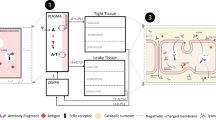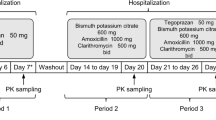Abstract
The present investigation was undertaken in order to determine the in vivo plasma protein binding of furosemide in kidney transplant patients and its possible consequence on furosemide effect. Using an equilibrium dialysis technique, serial plasma samples of furosemide taken after intravenous administration were dialyzed against an equal volume of isotonic Krebs Ringer bicarbonate buffer (pH7.4). Dialysis was performed at 37°C for 5 hr, and furosemide concentrations (total as well as free) were analyzed by HPLC using fluorescence detection. It was observed that kidney transplant patients on concomitant sulfisoxazole treatment (KT+) had a significantly greater value for percent free of furosemide as compared to transplant patients not on sulfisoxazole (KT-) (4.4±0.8 for KT+ vs. 1.7±0.3% for KT-;p<0.01) as well as to healthy volunteers (4.4±0.8 for KT+ vs. 1.2±0.2% for controls;p<0.01). In addition, kidney transplant patients not on concomitant sulfisoxazole treatment had a significantly higher value for percent free of furosemide with respect to healthy volunteers (p<0.05). Nonlinear plasma protein binding was also observed for one patient, who had values for percent free of furosemide ranging from 1.3 to 12.9%. However, no significant correlation was found between the fraction of the dose excreted unchanged in the urine and percent free of furosemide.
Similar content being viewed by others
References
S. W. Boobis. Alteration of plasma albumin in relation to decreased drug binding in uremia.Clin. Pharmacol. Ther. 22:147–153 (1977).
R. Gugler and D. L. Azarnoff. Drug protein binding and the nephrotic syndrome.Clin. Pharmacokin. 1:25–35 (1976).
M. M. Reidenberg. The binding of drugs to plasma proteins from patients with poor renal function.Clin. Pharmacokin. 1:121–125 (1976).
M. M. Reidenberg, I. Odar-Cederlöf, C. Von Bahr, O. Borgå, and F. Sjöqvist. Protein binding of diphenylhydantoin and desmethylimipramine in plasma from patients with poor renal function.N. Engl. J. Med. 285:264–267 (1971).
I. Sjöholm, A. Kober, I. Odar-Cederlöf, and O. Borgå. Protein binding of drugs in uremic and normal serum: the role of endogenous binding inhibitors.Biochem. Pharmacol. 25:1205–1213 (1976).
F. Andreasen, H. E. Hansen, and E. Mikkelsen. Pharmacokinetics of furosemide in anephric patients and in normal subjects.Eur. J. Clin. Pharmacol. 13:41–48 (1978).
F. Andreasen and P. Jakobsen. Determination of furosemide in blood plasma and its binding to proteins in normal plasma and in plasma from patients with acute renal failure.Acta Pharmacol. Toxicol. 35:49–57 (1974).
F. Andreasen and E. Mikkelsen. Distribution, elimination and effects of furosemide in normal subjects and in patients with heart failure.Eur. J. Clin. Pharmacol. 12:15–22 (1977).
F. Andreasen, O. L. Pedersen, and E. Mikkelsen. Distribution, elimination and natriuretic effect of furosemide in patients with severe arterial hypertension.Eur. J. Clin. Pharmacol. 14:237–244 (1978).
J. Prandota and A. W. Pruitt. Furosemide binding to human albumin and plasma of nephrotic children.Clin. Pharmacol. Ther. 17:159–166 (1975).
A. Rane, J. P. Villeneuve, W. J. Stone, A. S. Nies, G. R. Wilkinson, and R. A. Branch. Plasma binding and disposition of furosemide in the nephrotic syndrome and in uremia.Clin. Pharmacol. Ther. 24:199–207 (1978).
D. E. Smith, E. T. Lin, and L. Z. Benet. Absorption and disposition of furosemide in healthy volunteers, measured with a metabolite specific assay.Drug Metab. Dispos. 8:337–342 (1980).
M. B. Burg. Tubular chloride transport and the mode of action of some diuretics.Kidney Int. 9:189–197 (1976).
M. Burg, L. Stoner, J. Cardinal, and N. Green. Furosemide effect on isolated perfused tubules.Am. J. Physiol. 225:119–125 (1973).
J. B. Hook and H. E. Williamson. Influence of probenecid and alterations in acid-base balance of the saluretic activity of furosemide.J. Pharmacol. Exp. Ther. 149:404–408 (1965).
B. Beermann, E. Dalén, and B. Lindström. Elimination of furosemide in healthy subjects and in those with renal failure.Clin. Pharmacol. Ther. 22:70–78 (1977).
R. E. Cutler, A. W. Forrey, T. G. Christopher, and B. M. Kimpel. Pharmacokinetics of furosemide in normal subjects and functionally anephric patients.Clin. Pharmacol. Ther. 15:588–596 (1974).
C. M. Huang, A. J. Atkinson, M. Levin, N. Levin, and A. Quintanilla. Pharmacokinetics of furosemide in advanced renal failure.Clin. Pharmacol. Ther. 16:659–666 (1974).
D. E. Smith, J. G. Gambertoglio, F. Vincenti, and L. Z. Benet. Furosemide kinetics and dynamics after kidney transplant.Clin. Pharmacol. Ther. 30:105–113 (1981).
W. J. Tilstone and A. Fine. Furosemide kinetics in renal failure.Clin. Pharmacol. Ther. 23:644–650 (1978).
H. L. Behm and J. G. Wagner. Errors in interpretation of data from equilibrium dialysis protein binding experiments.Res. Commun. Chem. Pathol. Pharmacol. 26:145–160 (1979).
T. N. Tozer, J. G. Gambertoglio, D. E. Furst, D. Avery, and N. H. G. Holford. Volume shifts during equilibrium dialysis and protein binding estimates—application to prednisolone binding in man.J. Pharm. Sci. (in press).
A. Yacobi and G. Levy. Effect of serum protein binding on sulfisoxazole distribution, metabolism, and excretion in rats.J. Pharm. Sci. 68:742–746 (1979).
Author information
Authors and Affiliations
Additional information
This work was supported in part by NIH Grant AM 20884 and by the Earl C. Anthony Fund.
Rights and permissions
About this article
Cite this article
Smith, D.E., Benet, L.Z. Plasma protein binding of furosemide in kidney transplant patients. Journal of Pharmacokinetics and Biopharmaceutics 10, 663–674 (1982). https://doi.org/10.1007/BF01062547
Received:
Revised:
Published:
Issue Date:
DOI: https://doi.org/10.1007/BF01062547




